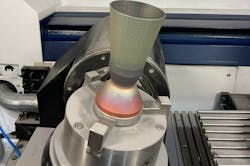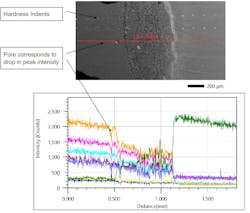Additive processes including electron beam additive manufacturing (EBAM), wire arc additive manufacturing (WAAM), and laser hybrid arc have been demonstrated for building tanks and structures, but to really explore our solar system and beyond, we need to focus on better ways to print propulsion devices for launch vehicles. Laser powder-bed fusion, also called laser metal fusion (LMF), and laser direct-energy deposition (DED), also called laser metal deposition (LMD), are tools to help us achieve these lofty goals.
TRUMPF’s laser application lab in Plymouth Township, MI, used an interesting method combining both LMF and LMD to create an additively manufactured rocket engine injector and nozzle.
We began this project with an injector designed to be printed in GR Cop 42, a copper alloy developed by NASA that provides improved thermal conductivity with printability in LMF powder bed machines. We then used the LMD process to print a wide bell-shaped nozzle for the exhaust gases.
The advantage of combining both processes gave us an intricate cooling channel design for fluid flow inside the injector chamber, along with thin wall features necessary for heat transfer. The freeform nature of LMD allows a wide flared-bell shape to be printed without the constraints of a powder bed. The combination of these laser AM techniques is the key to unlocking space exploration.
Welds
In laser AM, DED is a process with similarities to conventional welding techniques.
A weld produced by LMD follows this basic process: a laser-induced melt pool is created on a component surface while metal powder is simultaneously added into it via a powder nozzle. The solid metal powder then melts, which creates a metallurgical bond to the material underneath. To protect the melt pool from the environment, shielding gas can be used. The melt pool solidifies due to thermal conduction and forms a weld bead with typical characteristics of a traditional weld (i.e., fusion or dilution and the presence of a heat-affected zone).
As more material is continuously melted and deposited, a structure can be built up, which can be considered one large weld deposit. If the process is combined with movement of the weld head, using a kinematics system, such as a CNC machine or robot, the weld bead(s) can be placed on a component with great precision and repeatability. Depending on placement of the bead(s), this process can be used for joining, cladding, component repair, and additive manufacturing.
Applications in space exploration
The space sector has applications that are suitable for production using additive manufacturing. Laser AM overcomes the limitations of conventional production techniques, such as production of fine features, internal cooling channels, and overhangs. It can also allow new innovations and increase the efficiency of existing manufacturing process chains.
Using the latest technology advancements, radical design concepts using DfAM (design for additive manufacturing) can become reality, and algorithmic design using machine learning and artificial intelligence can help us produce completely unseen and unheard of designs.
We have already accomplished near-net-shape printing of components using the blown powder LMD process for thrust chamber extension nozzles (see Fig. 1), so it’s obvious this process has huge potential for space exploration.
Technology background
A general knowledge of involved process parameters is important to successfully set up and run an additive LMD application process. But the most critical of these needed for a stable process are laser power, powder feed rate, and process speed. When isolating these three parameters in more detail, the following influences can be described:
- The laser power provides the energy to melt the involved materials. It is the main driver for size of the dilution, fusion, and heat-affected zone. Laser power also affects the track width and overall heat input into the component.
- The powder feed rate defines the mass flow of powder introduced to the process zone. It can generally be assumed this parameter influences mainly the bead height, as well as the dilution with the material underneath.
- The process speed at which the nozzle is moved along a workpiece influences the bead or track height and dilution.
The combination of these three base parameters directly affects the layer height of an additively manufactured LMD component. For optimum processing conditions, once the layer height is stable, then the entire build process will be more stable, and a better printed part can result.
One interesting space exploration application for the blown powder LMD process is a thrust chamber extension on a rocket engine. We produced an example of this structure, using nickel-based superalloy 718 on top of a laser powder bed LMF-printed GR Cop 42 copper nozzle component.
Manufacturing hybrid parts
In creating this truly hybrid part, different laser AM processes and materials were used. The copper portion of the part was manufactured with an LMF printing system using a green laser source at 515-nm wavelength. It has advantages for highly reflective materials like copper, because the laser energy absorption rate is much higher.
The 718 portion of the component was built using an infrared (IR) 1030 nm disk laser and an LMD printing process. Maximum output power for the IR portion of the build was 12 kW, but in this work the laser power was only 1.4 kW with 1200 mm/min process speed, with powder feed rate 15 g/min utilization—resulting in ultimate build rates of up to 840 g per hour.
The resulting powder utilization exceeded 90%. This was achieved with a multijet powder nozzle and laser beam shaping (2-in-1 fiber with BrightLine weld technology). The final structure ended up at 100 mm in z-height, with a wall thickness of approximately 3 mm. This part was built in less than 45 minutes using a continuous spiral strategy—resulting in a final layer height of approximately 500 µm. To produce the 10-degree overhang from vertical, the parts position was manipulated with a tilt turntable (see Fig. 1).
The key to a successful build is to ensure strong bonding of GR Cop 42 and 718, essentially a dissimilar metal weld. We attempted to increase the size of the fusion zone between the two materials with increasing laser power and reduced process velocity for the first layer.
A cross-section of this mixing layer can be found in Figure 2 and indicates visually a quality bond of the two materials. Upon cross sectioning and etching, it appears there is a double-layered fusion zone between the materials. A larger mixing zone on the 718 side of the structure was apparent, with a thinner layer on the copper side.To quickly assess the material properties, particularly in the fusion zone between the two materials, a Vickers hardness test (HV0.1) was used. Results show relatively constant values on the 718 side, followed by a reduced hardness in the mixing zone between the two materials. On the copper side, hardness values increase initially but drop again when approaching the interface. The lowest measured hardness values are in the intermediate area of transition zone between the 718 and copper (see Fig. 2, arrow at top right).
The interface area was also examined briefly using energy dispersive x-ray (EDX) analysis in line scan mode, along with a high-power SEM image (see Fig. 3). The chemistry follows from the nickel alloy side to the copper alloy side with expected intermetallics in the interface. Low peak intensity coincides with the presence of a defect/pore (spatter), obviously from ejection of metal when confronted with the higher laser power at the higher wavelength. Other observations shown in the SEM image include: the lack of fusion on the 718 side, the presence of defects (which are very different from Vickers hardness indents), and the very good as-printed density on the copper side.Further work
This initial investigation of combining two different laser AM processes, LMF with LMD, with different materials, nickel and copper, resulted in a truly hybrid component. There is definitely interest in exploring this study further to create novel parts for space exploration or other applications.
A more in-depth analysis of the bonding between the two materials is recommended. Process parameter adjustment, or use of post heat treatment (such as stress relief, etc.), will probably result in enhanced characteristics of the mixing area, especially to improve mechanical properties such as strength. The information in this study could also be used to design further experiments to evaluate the bonding between the two materials produced with different additive manufacturing methods, such as laser wire, or even WAAM with an initial LMF portion.
Another optimization method from the material side might include the use of a “buttering layer” with Monel, or the deposition of a graded-material approach. This gradually changes the composition of the material from copper to nickel in different proportions to produce a better-blended interface zone. Graded or functionally graded materials using the LMD method will allow tailored chemistries in the mixed zone, resulting in optimized bonding of nickel-based super alloys, copper alloys, and better overall material properties.
Ultimately, the advantage of combining both processes—the high detail resolution of LMF and the freeform nature of LMD—creates the best of both worlds for rocket engines and other space-based components. LMF can be used to build intricate cooling channels for fluid flow inside an injector chamber, along with thin wall features, whereas LMD enables a wide flared-bell shape to be printed without the constraints of a powder bed by use of a tilt turntable, and a faster overall build rate. The combination of these laser AM techniques is key to unlocking space exploration.


